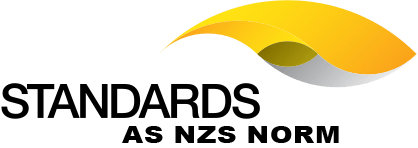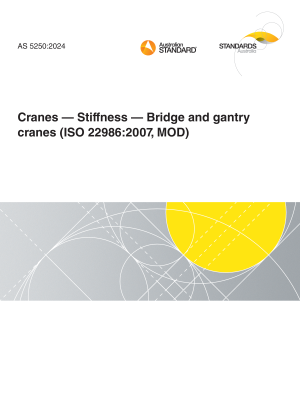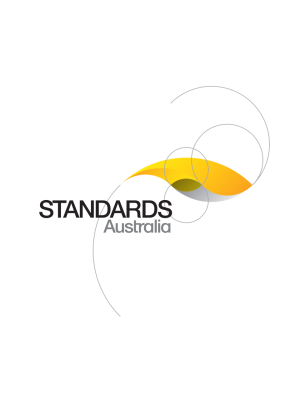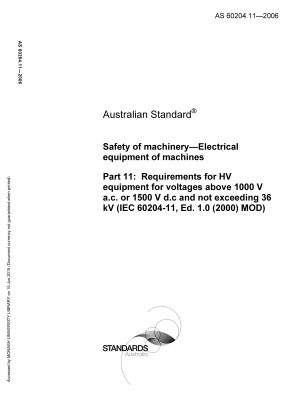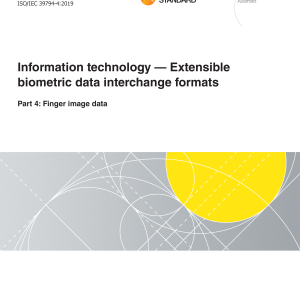🔍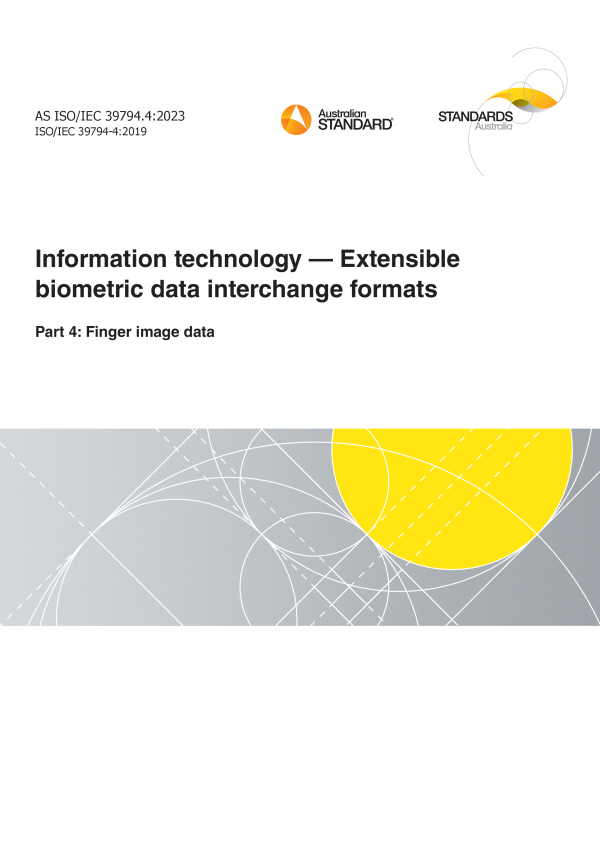

Purchase the full subscription package now and enjoy a 40% discount, along with free updates for future editions.
AS ISO/IEC 39794.4:2023
$293.48
Information technology – Extensible biometric data interchange formats, Part 4: Finger image data
AS ISO/IEC 39794.4:2023 identically adopts and modifies ISO/IEC 39794 4:2019, which specifies generic extensible data interchange formats for the representation of friction ridge image data
Table of contents
Header
About this publication
Preface
Foreword
Introduction
1 Scope
2 Normative references
3 Terms and definitions
4 Abbreviated terms
5 Conformance
6 Modality specific information
6.1 Capture recommendations
6.1.1 Fingerprint image
6.1.2 Palm image
6.2 Image coordinate system considerations
6.3 Image representation requirements
6.3.1 General
6.3.2 Colorspace
6.3.3 Pixel aspect ratio
6.3.4 Bit-depth
6.3.5 Image spatial sampling rate
7 Abstract data elements
7.1 Purpose and overall structure
7.2 Finger image data block
7.3 Version block
7.4 Representation blocks
7.5 Position
7.6 Impression
7.7 Image data format
7.7.1 Supported data format
7.7.2 PGM encoding definition
7.8 Image data
7.9 Capture date/time block
7.10 Capture device block
7.10.1 Model identifier block
7.10.2 Capture device technology identifier
7.10.3 Certification identifier blocks
7.11 Quality blocks
7.12 Spatial sampling rate block
7.13 Position computed by capture device
7.14 Original rotation
7.15 Image rotated to vertical
7.16 Image has been lossily compressed
7.17 Segmentation blocks
7.18 Annotation blocks
7.19 PAD data block
7.20 Comment blocks
7.21 Vendor specific data blocks
8 Encoding
8.1 Tagged binary encoding
8.2 XML encoding
9 Registered BDB format identifiers
Annex A
A.1 ASN.1 module for tagged binary encoding
A.2 XML schema definition for XML encoding
Annex B
B.1 Sample ASN.1 encoding for finger image data
B.2 Sample XML encoding for finger image data
Annex C
C.1 Overview
C.2 Conformance test assertions
Annex D
D.1 Image quality specification for AFIS systems
D.1.1 General
D.1.2 Fingerprint scanner
D.1.2.1 Overview
D.1.2.2 Linearity
D.1.2.2.1 Requirement
D.1.2.2.2 Background
D.1.2.3 Geometric accuracy
D.1.2.3.1 Requirement (across-bar)
D.1.2.3.2 Requirement (along-bar)
D.1.2.3.3 Background
D.1.2.4 Spatial frequency response
D.1.2.4.1 Requirements
D.1.2.4.2 Background
D.1.2.5 Signal-to-noise ratio
D.1.2.5.1 Requirement
D.1.2.5.2 Background
D.1.2.6 Grey-level uniformity
D.1.2.6.1 Requirement — Adjacent row, column uniformity
D.1.2.6.2 Requirement — Pixel-to-pixel uniformity
D.1.2.6.3 Requirement — Small area uniformity
D.1.2.6.4 Background
D.1.2.7 Finger image quality
D.1.2.7.1 Requirement — Fingerprint grey range
D.1.2.7.2 Background
D.1.2.7.3 Requirement — Finger artefacts and anomalies
D.1.2.7.4 Background
D.1.2.7.5 Requirement — Fingerprint sharpness and detail rendition
D.1.2.7.6 Background
D.1.3 Identification flats
D.1.3.1 Overview
D.1.3.2 Requirement — Capture protocol
D.1.3.3 Background
D.1.3.4 Requirement — Verifiable finger sequence data
D.1.3.5 Background
D.2 Image quality specification for personal verification
D.2.1 General
D.2.2 Requirements
D.2.2.1 Geometric accuracy
D.2.2.1.1 Requirement #1 (across-bar)
D.2.2.1.2 Requirement #2 (along-bar)
D.2.2.1.3 Background
D.2.2.2 Spatial frequency response (SFR)
D.2.2.2.1 Requirements
D.2.2.2.2 Background
D.2.2.3 Grey-level uniformity
D.2.2.3.1 Requirement #1 — Adjacent row, column uniformity
D.2.2.3.2 Requirement #2 — Pixel to pixel uniformity
D.2.2.3.3 Requirement #3 — Small area uniformity
D.2.2.3.4 Requirement #4 — Noise
D.2.2.3.5 Background
D.2.2.4 Fingerprint image quality
D.2.2.4.1 Requirement #1 — Fingerprint grey range
D.2.2.4.2 Background
D.2.2.4.3 Requirement #2 — Fingerprint artefacts and anomalies
D.2.2.4.4 Background
D.2.2.4.5 Requirement #3 — Fingerprint sharpness and detail rendition
D.2.2.4.6 Background
D.3 Requirements and test procedures for optical fingerprint scanners
D.3.1 General
D.3.2 Testing prerequisites
D.3.2.1 Requirements on the testing laboratory
D.3.2.2 Requirements on the test object
D.3.2.3 Requirements on the evaluation software
D.3.2.4 Demands on the test targets
D.3.2.4.1 Test targets for optical fingerprint scanner working on the principle of frustrated total internal reflection in the bright field
D.3.2.4.2 Test targets for optical fingerprint scanner working on the principle of frustrated total internal reflection in the dark field
D.3.3 Requirements and test procedures
D.3.3.1 Investigation of the greyscale linearity
D.3.3.1.1 Requirements
D.3.3.1.2 Background
D.3.3.1.3 Used targets
D.3.3.1.3.1 Test targets for optical fingerprint scanner working on the principle of frustrated total internal reflection in the bright field
D.3.3.1.3.2 Test targets for optical fingerprint scanner working on the principle of frustrated total internal reflection in the dark field
D.3.3.1.4 Test procedure
D.3.3.1.4.1 Test step 1
D.3.3.1.4.2 Test step 2
D.3.3.1.4.3 Test step 3
D.3.3.1.5 Requirement compliance
D.3.3.2 Investigation of the spatial sampling rate and geometrical accuracy
D.3.3.2.1 Requirements
D.3.3.2.2 Background
D.3.3.2.3 Used targets
D.3.3.2.3.1 Test targets for optical fingerprint scanner working on the principle of frustrated total internal reflection in the bright field
D.3.3.2.3.2 Test targets for optical fingerprint scanner working on the principle of frustrated total internal reflection in the dark field
D.3.3.2.4 Test procedure
D.3.3.2.4.1 Test step 1
D.3.3.2.4.2 Test step 2
D.3.3.2.4.3 Test step 3
D.3.3.2.5 Requirement compliance
D.3.3.3 Investigation of the contrast transfer function
D.3.3.3.1 Requirements
D.3.3.3.2 Background
D.3.3.3.3 Used targets
D.3.3.3.3.1 Test targets for optical fingerprint scanner working on the principle of frustrated total internal reflection in the bright field
D.3.3.3.3.2 Test targets for optical fingerprint scanner working on the principle of frustrated total internal reflection in the dark field
D.3.3.3.4 Test procedure
D.3.3.3.4.1 Test step 1
D.3.3.3.4.2 Test step 2
D.3.3.3.4.3 Test step 3
D.3.3.3.5 Requirement compliance
D.3.3.4 Investigation of the signal-to-noise ratio and the grey–level uniformity
D.3.3.4.1 Requirements
D.3.3.4.2 Background
D.3.3.4.3 Used targets
D.3.3.4.3.1 Test targets for optical fingerprint scanner working on the principle of frustrated total internal reflection in the bright field
D.3.3.4.3.2 Test targets for optical fingerprint scanner working on the principle of frustrated total internal reflection in the dark field
D.3.3.4.4 Test procedure
D.3.3.4.4.1 Test step 1
D.3.3.4.4.2 Test step 2
D.3.3.4.5 Requirement compliance
D.3.3.5 Investigation of the grey scale range of finger images
D.3.3.5.1 Requirements
D.3.3.5.2 Background
D.3.3.5.3 Used targets
D.3.3.5.4 Test procedure
D.3.3.5.4.1 Test step 1
D.3.3.5.4.2 Test step 2
D.3.3.5.5 Requirement compliance
Annex E
E.1 Purpose
E.2 Recommendations for 2D contact fingerprint image capture devices
E.2.1 Image quality specifications
E.2.2 Recommended finger positioning
E.2.3 Illumination, lighting, and activation
E.2.4 Cleanness of platen and latent prints
E.2.5 Moisturizing
E.2.6 Drying
E.2.7 Missing
E.2.8 Finger selection and order of capture
E.2.9 Assessing fingerprint image quality
E.2.10 Existing data treatment
E.2.11 Image capture factors
E.2.12 Operation
E.2.13 Example configurations
E.2.13.1 One finger in a standing position
E.2.13.2 Four fingers in a sitting position
E.2.14 Indications to biometric operational personnel
E.2.15 Confirmation
E.3 Guidelines for image data
E.3.1 Image quality metrics
E.3.2 Human interface (displaying capturing/captured image)
E.3.3 Pre-processing
E.4 Fingerprint image capture software
E.5 Law enforcement finger size recommendations
E.6 Possible references
Annex F
F.1 Requirements and guidelines
F.1.1 General
F.1.2 General
F.1.2.1 Wavelet scalar quantization (WSQ) compression
F.1.2.2 Structure of compressed data
F.1.2.3 Interchange format
F.1.2.4 Abbreviated format for compressed image data
F.1.2.5 Abbreviated format for table-specification data
F.1.3 Requirements
F.1.3.1 Interchange format requirements
F.1.3.2 Encoder requirements
F.1.3.3 Decoder requirements
F.2 Mathematical definitions
F.2.1 Source finger image
F.2.2 Subband coding of finger images
F.2.2.1 Two-channel subband coder (in one dimension)
F.2.2.2 Linear phase wavelet filters
F.2.2.3 Constraints on filter length
F.2.2.4 Symmetric boundary conditions for the DWT
F.2.2.5 Symmetric subband synthesis
F.2.2.6 Wavelet decomposition in two dimensions
F.2.2.7 Subband structure
F.2.3 Quantization
F.2.4 Entropy coding
F.2.4.1 Data sequence
F.2.4.2 Huffman encoder
F.3 Compressed data formats
F.3.1 General aspects of the compressed data format specifications
F.3.1.1 Constituent parts
F.3.1.1.1 Parameters
F.3.1.1.2 Markers
F.3.1.1.3 Marker assignments
F.3.1.1.4 Marker segments
F.3.1.1.5 Entropy‑coded data segments
F.3.1.2 Syntax
F.3.1.3 Conventions for syntax figures
F.3.1.4 Conventions for symbols, code lengths and values
F.3.2 General syntax
F.3.2.1 High-level syntax
F.3.2.2 Frame header syntax
F.3.2.3 Block header syntax
F.3.2.4 Table-specification and miscellaneous marker segment syntax
F.3.2.4.1 Transform table‑specification
F.3.2.4.2 Quantization table‑specification syntax
F.3.2.4.3 Huffman table‑specification syntax
F.3.2.4.4 Restart interval definition syntax
F.3.2.4.5 Comment syntax
F.3.3 Abbreviated format for compressed image data
F.3.4 Abbreviated format for table-specification data
F.4 Huffman table specification
F.4.1 General
F.4.2 Marker segments for Huffman table specification
F.4.3 Conversion of Huffman tables specified in interchange format to tables of codes and code length
F.4.4 Bit ordering within bytes
F.5 Typical parameter table values
F.5.1 Source image normalization
F.5.2 Transform table
F.5.3 Adaptive quantization of DWT output
F.5.3.1 General
F.5.3.2 Subband variance computation
F.5.3.3 Bin width computation
F.5.3.4 Iterative procedure for computing bin widths
F.5.4 Huffman coding of quantizer indices
Bibliography
Cited references in this standard
Content history
[Current]
[Superseded]
AS ISO/IEC 19794.4-2007 REC:2017
AS ISO/IEC 19794.4:2007
DR AS ISO/IEC 39794.4:2023
Please select a variation to view its description.
| Published | 13/10/2023 |
|---|---|
| Pages | 97 |
Please select a variation to view its pdf.
